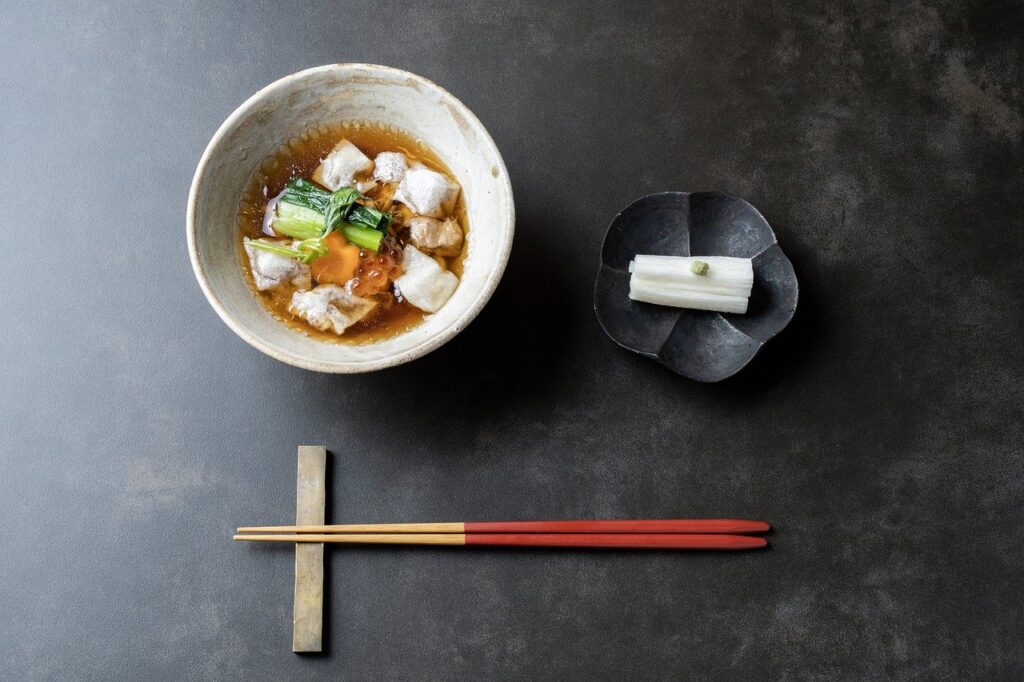Japan is a paradise for food lovers, offering an unparalleled culinary experience that reflects its rich culture, tradition, and innovation. From bustling city streets to serene rural villages, Japanese cuisine showcases a delightful array of flavors, textures, and presentations that captivate the senses. Whether you are a seasoned traveler or planning your first trip to Japan, this comprehensive guide will help you navigate the country’s diverse food landscape and indulge in its gastronomic wonders.
The Foundations of Japanese Cuisine
Rice: The Staple of Japanese Diet
Rice, or gohan, is the cornerstone of Japanese cuisine, serving as a fundamental component in most meals. This versatile grain is not only a primary food source but also a cultural symbol of prosperity and well-being. Japanese rice is short-grain and sticky when cooked, making it ideal for sushi, onigiri (rice balls), and various rice dishes. Don’t miss trying takikomi gohan, a seasoned rice dish cooked with vegetables, meat, or seafood.
Umami: The Fifth Taste
Umami, often described as a savory or meaty flavor, is a defining characteristic of Japanese cuisine. Discovered by Japanese scientist Kikunae Ikeda in 1908, umami is present in ingredients like kombu (kelp), katsuobushi (bonito flakes), soy sauce, and miso. These ingredients are frequently used to enhance the depth of flavor in dishes, making Japanese food uniquely satisfying and delicious.
Seasonal and Regional Ingredients
Japanese cuisine places a strong emphasis on seasonality and regionality. Known as shun, the concept of eating seasonal ingredients ensures that dishes are fresh and flavorful. Regional specialties, or meibutsu, highlight the unique culinary traditions and local produce of different areas in Japan. Exploring these regional dishes allows you to experience the diverse tastes that Japan has to offer.
Iconic Japanese Dishes
Sushi: Artistry in Simplicity
Sushi is arguably the most internationally recognized Japanese dish. It comes in various forms, including nigiri (hand-pressed rice topped with seafood), maki (rolled sushi), and sashimi (slices of raw fish without rice). The key to great sushi lies in the quality of the ingredients and the skill of the chef. Visit a high-end sushi restaurant, or sushi-ya, to experience the meticulous preparation and presentation of this culinary art form.
Ramen: The Ultimate Comfort Food
Ramen, a beloved Japanese noodle soup, has garnered a global following. This dish features wheat noodles served in a flavorful broth, typically made from pork, chicken, or fish, and topped with ingredients like chashu (braised pork), soft-boiled eggs, and seaweed. There are several regional variations of ramen, such as tonkotsu (rich pork bone broth) from Fukuoka and shoyu (soy sauce-based broth) from Tokyo. Each region offers a unique take on this comforting classic.
Tempura: Crispy Perfection
Tempura consists of seafood, vegetables, or even meat coated in a light batter and deep-fried to crispy perfection. The key to exceptional tempura is the batter, which should be airy and delicate, and the frying technique, which should result in a light, non-greasy texture. Tempura is often served with a dipping sauce made from soy sauce, mirin, and dashi, or simply with a sprinkle of sea salt.
Yakitori: Grilled Skewers Delight
Yakitori, or grilled chicken skewers, is a popular dish enjoyed at izakayas (Japanese pubs) and street stalls. The skewers feature various parts of the chicken, such as thigh, breast, liver, and skin, seasoned with either tare (a sweet soy-based sauce) or shio (salt). Enjoying yakitori with a cold beer or sake is a quintessential Japanese dining experience.
Soba and Udon: Noodle Varieties
Soba and udon are traditional Japanese noodles that differ in their ingredients and texture. Soba noodles, made from buckwheat flour, are thin and have a nutty flavor. They can be served cold with a dipping sauce or hot in a broth. Udon noodles, made from wheat flour, are thick and chewy, typically served in a hot, savory broth. Both noodle varieties are versatile and can be enjoyed with various toppings and accompaniments.
Traditional Japanese Meals
Kaiseki: The Pinnacle of Japanese Dining
Kaiseki is a multi-course meal that represents the highest form of Japanese culinary art. It originated from the tea ceremony and has evolved into a sophisticated dining experience that highlights seasonal ingredients, meticulous preparation, and exquisite presentation. A typical kaiseki meal includes an appetizer, sashimi, a simmered dish, a grilled dish, and a dessert. Dining at a kaiseki restaurant offers a glimpse into the elegance and artistry of Japanese cuisine.
Bento: A Meal in a Box
Bento is a single-portion boxed meal that is both convenient and visually appealing. Bento boxes typically include rice, protein (such as fish, meat, or tofu), and a variety of side dishes like pickled vegetables and tamagoyaki (sweet rolled omelette). Bento can be found in convenience stores, train stations, and specialized bento shops. They are perfect for a quick and satisfying meal on the go.
Shabu-Shabu and Sukiyaki: Hot Pot Delights
Shabu-shabu and sukiyaki are two popular Japanese hot pot dishes. Shabu-shabu involves swishing thin slices of meat and vegetables in a pot of boiling broth, then dipping them in savory sauces before eating. Sukiyaki, on the other hand, features meat and vegetables simmered in a sweet soy-based sauce and dipped in raw egg before consumption. Both dishes are interactive and communal, making them perfect for sharing with friends and family.
Japanese Street Food
Takoyaki: Octopus Balls
Takoyaki, or octopus balls, are a beloved street food originating from Osaka. These bite-sized snacks are made from a batter filled with pieces of octopus, tempura scraps, pickled ginger, and green onions, cooked in a special takoyaki pan. They are typically topped with takoyaki sauce, mayonnaise, bonito flakes, and seaweed powder. Takoyaki is a must-try for its crispy exterior and gooey, flavorful interior.
Okonomiyaki: Savory Pancakes
Okonomiyaki, often referred to as Japanese savory pancakes, is a popular street food and casual dining dish. It is made from a batter mixed with shredded cabbage, and various ingredients like meat, seafood, and vegetables, cooked on a griddle. The pancake is then topped with okonomiyaki sauce, mayonnaise, bonito flakes, and seaweed. Hiroshima and Osaka are famous for their distinct styles of okonomiyaki, each offering a unique twist on this versatile dish.
Taiyaki: Fish-Shaped Pastries
Taiyaki is a fish-shaped pastry filled with sweet red bean paste, custard, chocolate, or other fillings. This delightful treat is cooked in a fish-shaped mold until crispy on the outside and soft on the inside. Taiyaki is a popular snack during festivals and can be found at street stalls and specialty shops.
Exploring Japanese Beverages
Sake: The National Drink
Sake, or Japanese rice wine, is an integral part of Japanese culture and dining. Made from fermented rice, sake comes in various styles and flavors, ranging from dry and crisp to rich and fruity. Sake can be enjoyed warm or chilled, depending on the type and personal preference. Visiting a sake brewery or participating in a sake tasting is a fantastic way to learn about the brewing process and appreciate the nuances of this traditional beverage.
Matcha: The Ceremonial Green Tea
Matcha, a finely ground green tea powder, is renowned for its vibrant color and unique flavor. It is traditionally used in Japanese tea ceremonies and has become popular worldwide for its health benefits and versatility. Matcha can be enjoyed as a hot tea, in lattes, or as an ingredient in various desserts and pastries. Experiencing a traditional tea ceremony is a serene and enlightening way to savor matcha and learn about its cultural significance.
Japanese Whiskey: World-Class Spirits
Japanese whiskey has gained international acclaim for its quality and craftsmanship. Distilleries like Yamazaki, Hakushu, and Nikka produce exceptional single malt and blended whiskeys that rival the best Scotch whiskeys. A visit to a Japanese whiskey distillery offers a glimpse into the meticulous production process and the opportunity to taste some of the finest spirits Japan has to offer.
Dining Etiquette and Tips
Respecting Japanese Dining Etiquette
Understanding and respecting Japanese dining etiquette enhances your culinary experience and shows appreciation for the culture. Here are some key points to keep in mind:
- Use chopsticks correctly: Avoid pointing, waving, or sticking chopsticks upright in a bowl of rice, as this is reminiscent of funeral rites.
- Say “Itadakimasu” before eating: This phrase means “I humbly receive” and is a way to express gratitude for the meal.
- Don’t pour your own drink: It’s customary to pour drinks for others and let them pour yours in return.
- Finish your food: Leaving food on your plate is considered wasteful and disrespectful.
Navigating Japanese Menus
Menus in Japan can be daunting for non-Japanese speakers, but many restaurants offer picture menus or English translations. Don’t hesitate to ask for recommendations or explanations from the staff. Embrace the adventure of trying new dishes and flavors that may be unfamiliar.
Finding the Best Food Spots
From Michelin-starred restaurants to hidden street stalls, Japan offers a plethora of dining options. Use online resources like


